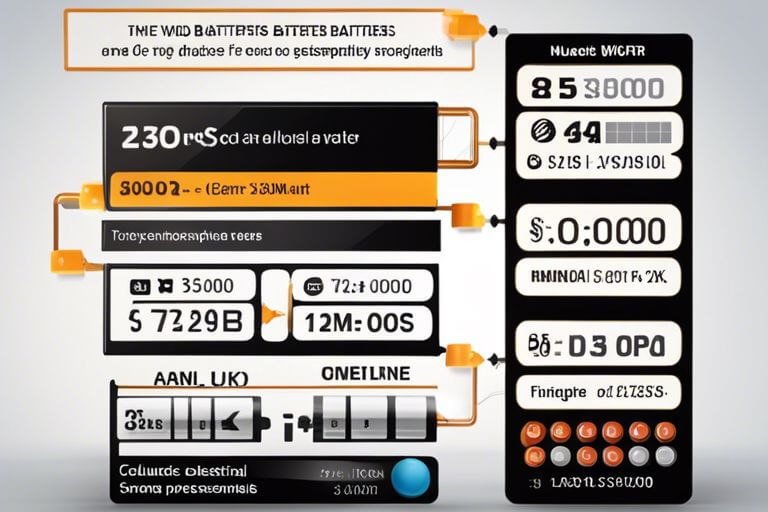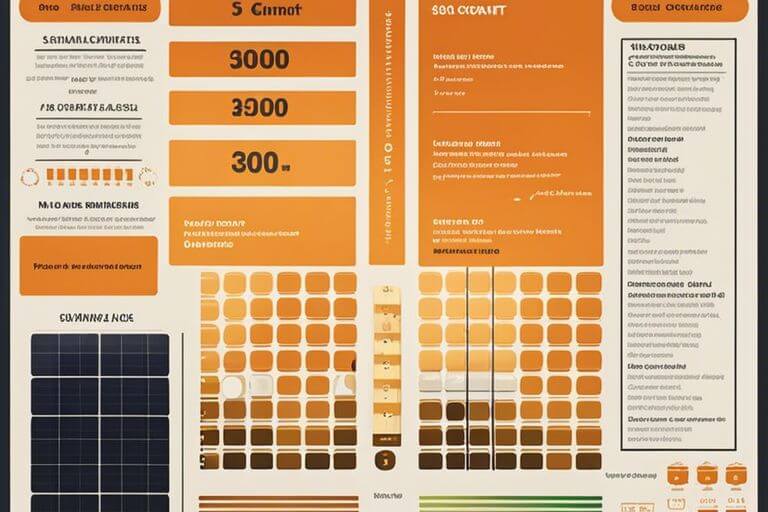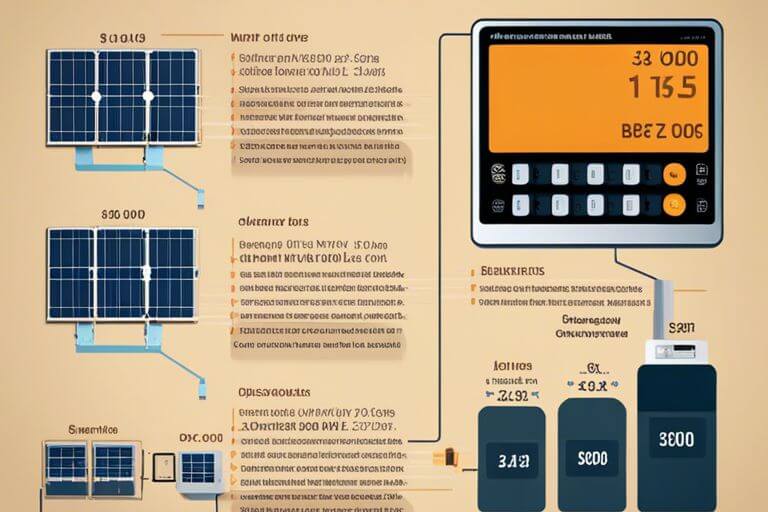Batteries are crucial for storing the excess power generated by your 3000 watt solar system during the day for use at night or on cloudy days. To determine how many batteries you need, you must consider factors like battery capacity, depth of discharge, and your energy consumption patterns. By calculating your daily energy usage and factoring in inefficiencies, you can determine the optimal number of batteries required to keep your solar system running smoothly and efficiently.
Key Takeaways:
- Battery Capacity: To support a 3000 watt solar system, you will need a battery bank with high capacity.
- Calculating Energy Usage: Determine the average energy usage per day to estimate the number of batteries needed.
- Consider Energy Storage: Factor in energy storage requirements for days with limited sunlight or high energy consumption.

System Requirements
A How Many Batteries Do I Need for a 3 kW Solar System? is an imperative question to consider when setting up a 3000 watt solar system. To determine the number of batteries required for your system, you need to understand two critical factors: power consumption and system efficiency.
Calculating Power Consumption
Any solar system requires batteries to store excess energy generated during sunny days for use during evenings or on cloudy days. To calculate the number of batteries needed for a 3000 watt solar system, you must first determine your average daily power consumption. This involves identifying the total wattage of all the devices you plan to power using the system and how long each device will run on a daily basis.
Determining System Efficiency
System efficiency plays a crucial role in determining the number of batteries necessary for your 3000 watt solar setup. Factors like energy conversion losses, wiring losses, and battery efficiency impact the overall efficiency of your system. It is imperative to consider these efficiency losses when sizing your battery bank to ensure optimal performance and reliable power supply.
System efficiency directly affects the number of batteries needed to support your 3000 watt solar system. By accounting for conversion losses, wiring inefficiencies, and battery performance, you can ensure that your system has enough energy storage capacity to meet your daily power needs consistently.
Battery Types and Characteristics
While setting up a 3000 watt solar system, you need to carefully consider the type and characteristics of batteries to optimize its efficiency. Different battery types offer unique features and benefits, so choosing the right one is crucial for the overall performance of your solar system. Knowing the differences between deep cycle, lithium-ion, and lead-acid batteries can help you make an informed decision that suits your specific needs.
Deep Cycle Batteries
An imperative component of a solar power system is the deep cycle battery. These batteries are designed to provide a steady amount of power over an extended period, making them ideal for solar energy storage. Deep cycle batteries are built to withstand deep discharges and recharges, making them durable and reliable for off-grid applications.
| Characteristics | Benefits |
| Long lifespan | Reliable power storage |
| Deep discharge capability | Perfect for off-grid use |
| Low maintenance | Cost-effective in the long run |
Lithium-Ion Batteries
Batteries play a critical role in storing the excess energy generated by your solar system for use during nighttime or cloudy days. Lithium-ion batteries are a popular choice due to their high energy density, longer lifespan, and faster charging capabilities. These batteries are lightweight, compact, and require minimal maintenance, making them convenient for residential solar installations.
Deep cycle batteries are commonly used in solar systems and are well-suited for providing a consistent flow of power. These batteries can be discharged to a low capacity without causing damage, making them efficient for storing and delivering solar energy.
Lead-Acid Batteries
Batteries are an imperative component of a solar power system, as they store the energy generated by your solar panels for later use. Lead-acid batteries are a traditional choice for solar applications due to their affordability and proven reliability. While not as efficient or long-lasting as lithium-ion batteries, lead-acid batteries are a cost-effective option for those on a budget.
This comprehensive overview of battery types and characteristics can help you determine the best option for your 3000 watt solar system. Consider factors such as lifespan, maintenance requirements, and upfront costs when choosing between deep cycle, lithium-ion, and lead-acid batteries to maximize the efficiency and performance of your solar energy system.
Sizing the Battery Bank
Not sure how many batteries you’ll need for your 3000-watt solar system? Visit How Many Batteries Is Needed For 3000 Watt Power Inverter for detailed information on battery requirements. Calculating the right number of batteries is crucial for the efficiency of your solar setup.
Calculating Total Watt-Hours Required
An important step in determining your battery needs is calculating the total watt-hours required to power your 3000-watt solar system. This calculation involves understanding the energy consumption of the system, factoring in efficiency losses, and determining the number of days the battery bank needs to support your energy needs during periods of low sunlight.
Selecting the Right Battery Configuration
With the total watt-hours determined, selecting the right battery configuration is important for optimal performance. Factors to consider include battery capacity, voltage, and whether you opt for lead-acid or lithium-ion batteries. Your choice will impact the overall cost, maintenance requirements, and lifespan of your battery bank.
Battery configuration also influences the discharge rate and depth of discharge. Ensuring the battery bank can handle the load from your 3000-watt solar system without compromising its longevity is key to a reliable and efficient setup.
System Voltage and Battery Voltage
12V, 24V, or 48V Systems
Your solar system’s voltage is a critical factor in determining the number of batteries you need to power it effectively. Systems generally operate at either 12V, 24V, or 48V, and this voltage level will dictate the type and quantity of batteries required to store and deliver energy efficiently.
Matching Battery Voltage to System Voltage
Any deviation in the battery voltage from the system voltage can lead to inefficiencies and potentially damage your solar power system. It’s necessary to match the battery voltage to the system voltage precisely to ensure seamless functionality and optimum performance.
Batteries with higher voltage capacities can store more energy, but they must align with the system voltage to avoid compatibility issues. If your system operates at 48V, using 12V batteries will not only be insufficient but can also cause damage due to the mismatch in voltage levels.

Charging and Discharging Cycles
All the batteries in your 3000 watt solar system go through charging and discharging cycles regularly. It’s vital to understand how these cycles affect your system’s overall performance and the lifespan of your batteries. By properly managing these cycles, you can maximize the efficiency and longevity of your solar power setup.
Depth of Discharge (DOD) Considerations
With your batteries, it’s crucial to consider the Depth of Discharge (DOD) to optimize their performance and lifespan. DOD refers to the percentage of a battery’s capacity that has been discharged. For example, a battery discharged to 50% DOD means half of its capacity has been used. To extend the life of your batteries, it’s recommended to avoid deep discharges frequently. Keeping the DOD lower, typically below 50%, can significantly increase the number of charging cycles your batteries can endure.
Cycle Life and Battery Longevity
One important factor to keep in mind is the Cycle Life of your batteries and how it impacts their longevity. Cycle life refers to the number of complete charge and discharge cycles a battery can undergo before its capacity degrades to a specified level. Higher quality batteries usually have a longer cycle life, meaning they can withstand more charging cycles over time. When opting for batteries for your 3000 watt solar system, prioritize those with a higher cycle life to ensure they can meet your long-term energy storage needs.
Batteries with a longer cycle life tend to be more expensive upfront, but they can offer better value in the long run by lasting longer and requiring fewer replacements. Investing in high-quality batteries with a longer cycle life can save you money and hassle in the future, making them a more reliable choice for your solar power system.
Environmental Factors and Battery Performance
Once again, the performance of your batteries in a 3000 watt solar system can be influenced by various environmental factors. Understanding how these elements impact the battery’s efficiency is crucial for maximizing the output of your solar setup.
Temperature Effects on Battery Capacity
One important factor to consider is the temperature at which your batteries will operate. Extreme temperatures, whether hot or cold, can significantly affect the capacity and lifespan of your batteries. Below is a breakdown of how temperature can impact battery performance:
Temperature Range
| Temperature | Effect on Battery Capacity |
| High temperatures | Decrease battery capacity |
| Low temperatures | Reduce battery efficiency |
Knowing how temperature affects your batteries will help you optimize their performance and longevity.
Humidity and Altitude Considerations
Considerations about humidity levels and altitude are also crucial when setting up your solar system. Changes in humidity and altitude can impact the overall efficiency of your batteries and solar panels.
Considerations about humidity and altitude levels are crucial in maintaining optimal battery performance. High humidity levels can lead to corrosion, while high altitudes can affect the airflow and cooling processes of your batteries.
Battery performance in your solar system can be influenced by various environmental factors. Understanding how temperature, humidity, and altitude affect your batteries’ efficiency is key to maximizing the output of your 3000 watt solar setup.
To wrap up
With this in mind, when planning for a 3000 watt solar system for your home, you will typically need around eight to ten deep cycle batteries. This number may vary depending on factors such as battery capacity, your energy usage patterns, and the number of backup days you want in case of solar power generation interruptions. It’s important to do a thorough assessment of your energy needs and consult with a professional to determine the exact number of batteries required for your specific setup.
Be mindful of, the batteries are a crucial component of your solar system, storing the energy generated by your solar panels for use when the sun isn’t shining. Ensuring you have the right number of batteries will help you maximize the benefits of your solar system and provide you with reliable power supply even during periods of low sunlight or power outages. Investing in the right batteries upfront will ultimately lead to a more efficient and sustainable solar energy system for your home.
FAQ
Q: How many batteries are needed for a 3000 watt solar system?
A: The number of batteries needed for a 3000 watt solar system will depend on the capacity of the batteries you choose. Typically, for a 3000 watt system, you may need around 8-12 deep cycle batteries.
Q: What type of batteries should be used for a 3000 watt solar system?
A: It is recommended to use deep cycle batteries for a 3000 watt solar system. Deep cycle batteries are designed to provide a steady amount of power over an extended period of time, making them ideal for use in solar power systems.
Q: How do I calculate the number of batteries needed for my 3000 watt solar system?
A: To calculate the number of batteries needed for your 3000 watt solar system, you will need to consider the capacity of the batteries, the voltage of the system, and your energy storage requirements. It is recommended to consult with a solar energy professional to determine the exact number of batteries needed for your specific setup.
